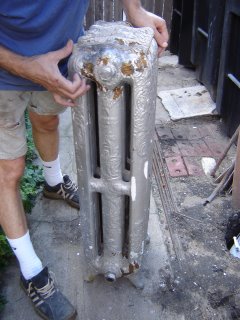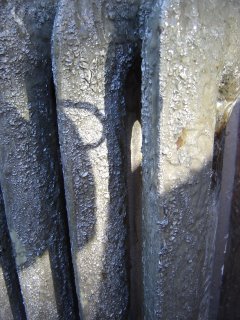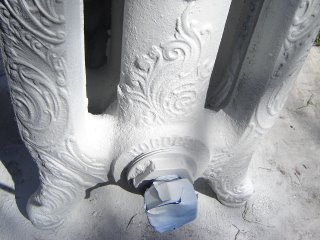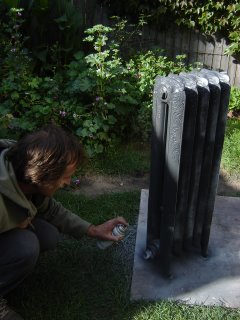 We were thinking of sandblasting the radiators, but when Steve mentioned this to our plumber, he said he had this great industrial strength stripper we could use that would remove the layers of paint lickety split.
We were thinking of sandblasting the radiators, but when Steve mentioned this to our plumber, he said he had this great industrial strength stripper we could use that would remove the layers of paint lickety split.It is a highly concentrated methol chloride. It is not for the faint of heart.
At left you see what we started out with. Chipping paint and diminished detail from the layers of paint applied over the years.

Steve set up what I like to call our own personal toxic waste dump and got to work. Apologies to all the environmental purists out there. At least we are contaminating our own land and not someone elses.
As soon as I saw the set up the first thing that I said to Steve was (with sarcasm), "Groundwater contamination....Oh that's just great."
 It's pretty damn disgusting. And to think I was thinking of growing vegetables in this little bed. Um, I don't think so. In fact, it's funny because people ask me why I don't grow vegetables because I seem to like gardening so much. I tell them every time that I won't do that until I change out the soil because I've sanded and scraped so much lead paint into our yard, I would not want to eat anything that grew there!
It's pretty damn disgusting. And to think I was thinking of growing vegetables in this little bed. Um, I don't think so. In fact, it's funny because people ask me why I don't grow vegetables because I seem to like gardening so much. I tell them every time that I won't do that until I change out the soil because I've sanded and scraped so much lead paint into our yard, I would not want to eat anything that grew there!Usually I get a strange look when I say this, but you guys know just how much wood has been handled in my yard. I'm sure you understand.

It took about 6 applications to clean off the majority of the paint.
Here's a close up of the chemical working.
Then we took a drill with a wire brush attachment and ground off the remaining paint build up.

Next we hit it with White primer spray paint. The detail really came back.


We then spray painted it with a charcoal gray. This is the first coat. I am really taken with the results. The improvement is pretty spectacular I think.

A few tips:
Make sure and tape over the valves when stripping, grinding, and spray painting. You don't want anything getting in there.
Wear long chemical proof gloves and safety glasses.
We think that sandblasting or power washing would get the remaining paint and rust off after the stripping, which would mean you wouldn't have to paint them and could leave them au naturale. How cool would that be?

14 comments:
Those are beautiful. I wish I had radiators. *sigh*
Gorgeous! I wish I had radiators too.
Beautiful! I have such fond memories of growing up in a house with radiators. I love the hissing and the clanking noises and the dry heat. Way to go! (I didn't plant any veggies this year- same reasoning, along with not having enough time. We could always grow our veggies in containers and that would solve the problem!)
Beautiful radiators. But having grown up in a house with them in a climate that really needed them, I can't say as I miss having them. I'm much happier with forced air, especially in the addition which is well enough insulated that it doesn't really even need it.
There are some plants (forget what off-hand) that will help absorb lead and other crud from the soil. Of course, then you have to dispose of them, but at least you'd have cleaner soil around the house.
So Allison- are you saying that for 8-10 layers of paint multi-strip will remove it in only one application? What do you do-wrap it in plastic overnight?
Steve calls radiators "the rolls royce of heating" because they are so costly, only the highest end homes would put in this system today. Now not everyone will agree with this, but we are glad we kept them. The heat is much more consistent and even than forced air with the blowing.
The citrus strip worked really well on our fireplace, taking up multiple courses of paint (there were a LOT) in one time, with using plastic sheeting overnight. (and it doesn't have the toxic fumes) I had to do multiple courses just because of the sheer size (one person handling the stripping while the stripper is drying is challenging). On the first course, I was able to get down to the marble in some areas.
When I worked on our radiators, they didn't take off that much paint, but I think that's because I didn't wait long enough and didn't drape in plastic. After this weekend (weather permitting) We'll have more a handle on sandblasting and how that works in comparison. (pressure washing so far did the best job)
I do all my vegetables in above ground planters. Not just because what we've done to it, but the questioning of what else is in the soil from before we bought the place.
I tried my darndest to keep the stripper with the radiators out of the grass, etc. through plastic sheeting, but I'm sure stuff is seeping into the soil
The radiator turned out beautifully and the fancy iron work made the turn-out that much more exciting. It's gorgeous!
I wouldn't trade my radiator heat for anything and feel lucky to have gotten a house that is still heated this way.
as much as i've been hankerin' for a trip to chicago lately, your folks with your talk of "radiators" has me scared...clearly california weather has made me soft...it makes everyone soft...the rad looks beautiful by the way...the detail is lovely!
Wow -- that detail is beautiful! I understand completely your feelings about the soil and possible contamination, too.
Wow, those look really great. I have this on our to-do list. We have a few pretty ones like yours, and a few boring ugly ones that we just threw covers over for now.
I too grew up in a house with radiators, so the tiny tings and not-so-tiny occasional bang are all nostalgic for me. And there's nothing like leaning up against them on a cold day, or letting your clothes warm on them before you get dressed in the morning!
Thanks for all the info, I love knowing a project is DIY do-able.
My favorite thing about radiators, especially in the winter, is hanging my towel on it before showering. Then when I grab use the towel after the shower, it is nice and toasty. As a child, I would melt snowballs on the radiator in the living room. When you're a kid, it doesn't take much to amuse you.
I am stripping my radiators as we speak (type). Which are identical to your as far as i can tell. I am curious how you were able to get into the center. I am stripping them in place with citrus strip and am finding it VERY difficult to get into the middle. Does it really matter?
I am stripping my radiators as we speak and I as far as I can tell they are identical to yours. Were you able to get into the middle and if so how? I am having a really difficult time getting paint off in there. Does it really matter?
Have you disconnected the radiators and taken them outdoors or are you stripping them in place? I only ask because to do a really good job in a quicker fashion, they need to be disconnected and removed from the house.
We were able to clean the middle out with after 20 coatings of stripper and scrubbing with steel wool and steel brushes and then hosing them off with high pressure from a garden hose. We had the radiator sitting in a tub (cement mixing tub from Home Depot) on a dirt pile away from our house in our yard.
I would say if you get a slim wire brush or get your hand in the middle with very coarse steel wool, you will be able to get it clean in about 20 coats. I won't lie to you- it was brutal!
Here is the kind of chemical we used:
(wear long chemical gloves!)
Easy Spray
Jasco
Premium Paint & Epoxy remover
Zar Paint & Varnish remover
Zip strip paint remover
Ace stripper xtra strength
(all contain 75%-80% methyl chloride)
Good luck!
Post a Comment